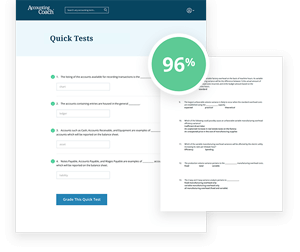For multiple-choice and true/false questions, simply press or click on what you think is the correct answer. For fill-in-the-blank questions, press or click on the blank space provided.
If you have difficulty answering the following questions, learn more about this topic by reading our Accounting Equation (Explanation).
For each of the transactions in items 2 through 13, indicate the two (or more) effects on the accounting equation of the business or company.
Information for Items 10 through 13
Company X provides consulting services to Client Q in May. Company X bills Client Q in May for the agreed upon amount of $5,000. The sales invoice shows that the amount will be due in June.
Expenses
Owner's Draws
Revenues
Net Income
Net Loss
Revenues
Only One
Only Two
Two Or More

Get Our Premium Accounting Equation Test Questions When You Join PRO
Receive instant access to our entire collection of premium materials, including our 1,800+ test questions.
View All PRO Features

Join PRO or PRO Plus and Get Lifetime Access to Our Premium Materials
Read all 3,033 reviewsFeatures
PRO
PRO Plus
Read 3,033 Testimonials